Jeff Rutland is one of those enviable people who quit the rat race to chase a passion. Packing in his job as a mechanical engineer, he set about launching a new bike brand - and, four years later, I'm in London to check out his ceation: the new Goldhawk Rodax road bike.

The Rodax sports a classic-looking Reynolds steel frameset and an on-trend selection of kit, including 1x11 gearing and hydraulic disc brakes. With its racy geometry and flat handlebars, it has the look of a rapid urban cruiser - a fixie for grown-ups, if you like.
But, as I discovered when I paid Jeff a visit at Goldhawk's Camden HQ, the Rodax was conceived as more than just a bling commuter - and early customers are already taking it on some epic adventures...
Jeff is busy at his laptop when I arrive, engrossed in a 3D model of his creation. Fizzing with enthusiasm for BikeCAD (a specialised program for designing bikes - and, apparently, exceptional value compared to industry CAD apps) he welcomes me in for a coffee and chat about his venture.
I had seen the Rodax on Goldhawk's website and was immediately intrigued. It's an unusual hybrid, blending the sleek, low-slung lines of a sporty road bike with flat bars and hydraulic disc brakes.
With a shiny red demo bike leaning against the wall next to us, I start by asking Jeff about the concept and his choice of SRAM 1x ("one-by") gearing; the Rodax has just a single chainring up front, rather than the conventional two.
"One-by was already popular on mountain bikes," Jeff explains, "and I love flat bar bikes rather than drop bar bikes. I was looking into 1x and SRAM kind of led the way.
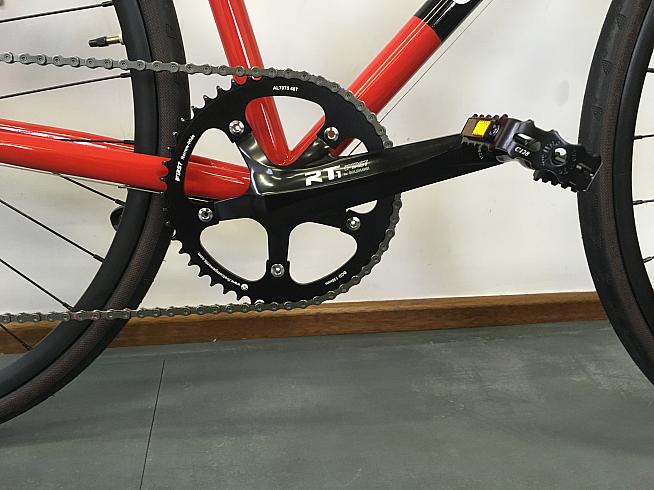
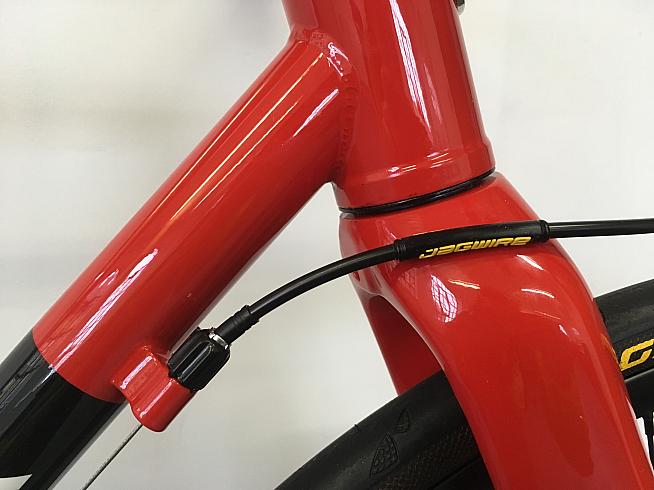
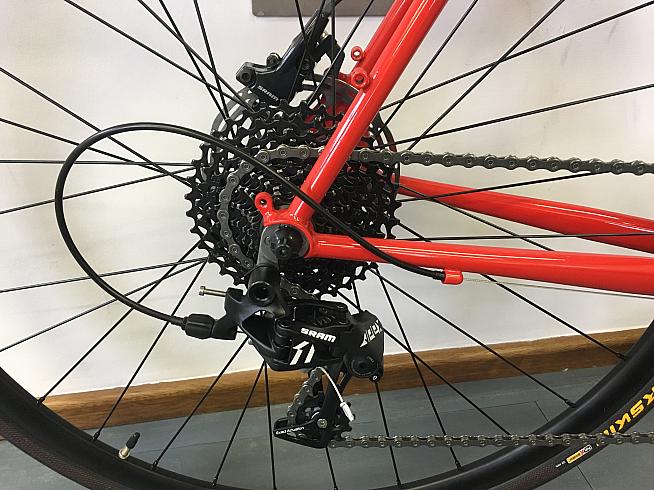
The drivetrain teams a SRAM clutched rear derailleur with an interesting single-ring chainset that Jeff commissioned especially from Taiwanese brand First.
"At the time," he says, "the biggest commercially available front chainring you could get was a 42 (I think it's a 44 now), and I was finding that I was spinning out all the time on a decent fast run, or my chain was down in 10 or 11 a lot of the time. So I wanted to gear it up a bit more because of the road type use that I do.
"I was over in Taiwan at a bike show there and literally did a double take on those cranks: this is exactly what I want for the bike, I just think they're lovely. They're nice spec, but I just love the look.
"They're a small boutique company and I got in touch with them and said I want to gear up a bit more, I want to give it a road gearing. Would you make me a 48-tooth narrow-wide?"
First agreed, and the result is a CNC-machined chainring that, in Jeff's view, allows a spread of gears that is ideally suited for all but the most extreme mountain riding.
"For me it's just the perfect gearing; first gear is one "worse", if you want to call it that, than first on a 50-34 compact. I've got virtually the whole spread of a compact in that 1x11. With the clean lines that I was so desperate to do, without all the gumph of a front mech that I hated. So, whilst I was kind of late to the party in realising that 1x11 was out there, certainly I think that for production 1x for the road we're ahead of the curve."
With the current trend to gravel and adventure bikes, there are now a growing number of brands agreeing with Jeff's approach and speccing 1x setups on their current models. But in his view, many of them are undergeared for the sort of fast road riding that he envisages the Rodax being used for.
"Yeah, you see a lot out there that are just mountain bike gears put on a road bike, and you see guys going along the road in 11th going like this..." He mimics furious pedalling.
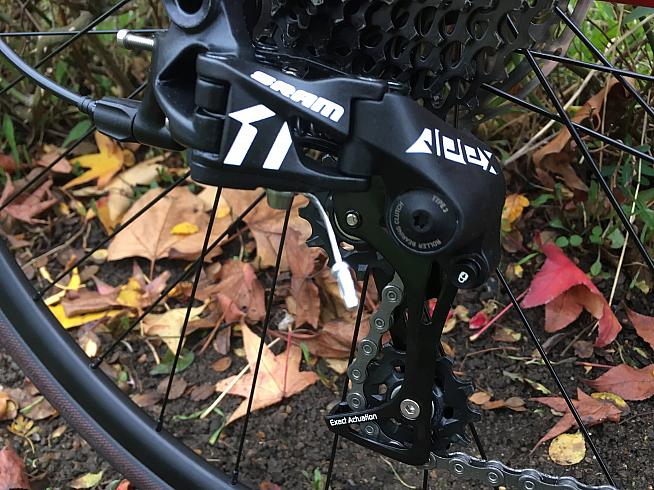
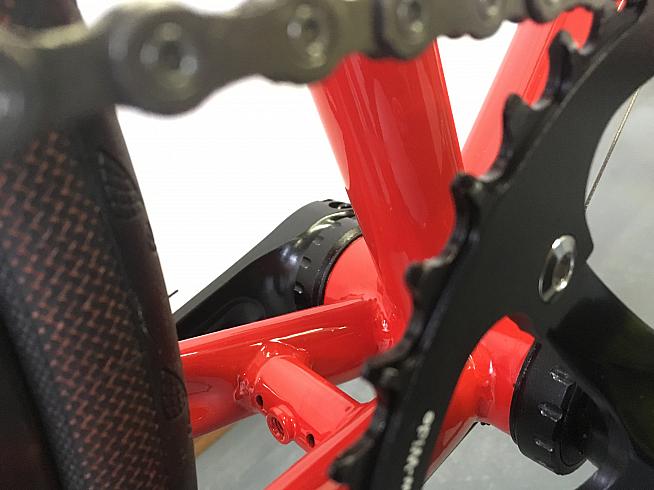
"Are you familiar with Swain's Lane in London?" Jeff asks me.
I am, having ridden it a couple of times en route to Rapha's annual Hell of the North ride which starts from the top of the hill. It's very steep.
"Well I did it on that" - he indicates the Rodax - "in the saddle. Just to prove that I could do it on this bike.
"Funnily enough I wrote a little piece for the website and I did some research, and obviously there's a Swain's Lane race: they took two minutes! Two minutes five. I couldn't get anywhere near their times laughs, but it proved a point.
"There's a lot being written about 1x11 now, and people's comments on it are covering the whole spectrum of cycling. You've got to bring it back to, what do you want it to do, what's it got to do for the bikes that you're trying to make, you know?
"The cassette is an 11-36 with a 48 on the front. That derailleur will take up to a 42T, but for the riding that these bikes are aimed at, it's not needed."
Glancing over the Rodax I can't see a braze-on for a front mech cable adjuster; is Jeff deliberately ruling out use of double chainrings?
"Well, it does have the braze-on actually..." Jeff corrects me. "When I was doing this we thought well, we'll sell framesets as well. And I thought if someone wants to build their own bike around the frameset then you've got to put it on there.
"And it's so on the line for me, I almost wish I hadn't, but if I hadn't I knew that I would have got 49.9% of people saying that I should have done. So I don't know whether the next batch will have it on or not, i haven't decided."
At least the braze-ons are beautifully done, I say - and are so discreet that I managed to miss it on first look.
"Yes, well the guys that did this are so good. They're so tidy. They do such a clean job that there are no blobs of welding. The first few prototypes were immaculate and then when the first batch came in we checked them all and were, 'Well, they've kept that through'. So I'm very pleased with those guys."
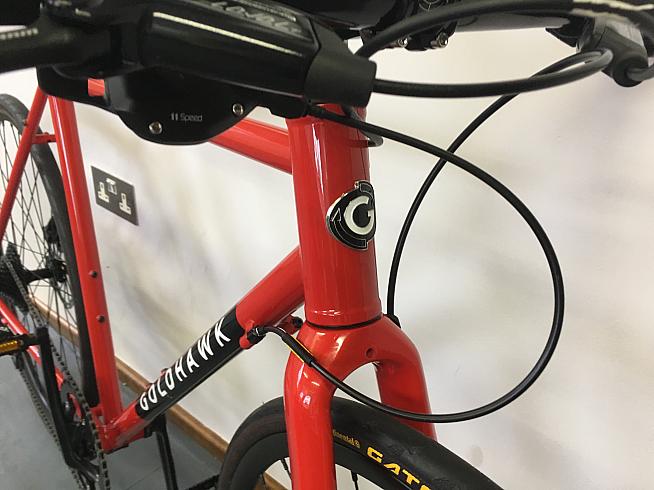
Where's the welding done?
"It's done in Taiwan. The company is Maxway. When I started this and made the decision to go with the steel frame, I actually knew Keith Noronha Managing Director at Reynolds from a completely non bike-related project - it was actually an oil and gas project.
"So I got chatting with Keith and I said 'Look, I'm in the process of designing this bike frame and I'm going to do it in Reynolds; who's a good manufacturer?' And he straight away said Maxway.
"I think they were the first to do Reynolds in Taiwan. It's a brother and sister that started it, and they're still small you know - they do thousands, but not millions."
What's the tube set?
"The tube set is 520, which is again perfect. My thinking these days is that if you want to go super lightweight you're going to go carbon. Really, you know, if weight is what it's all about. The difference between Reynolds 520, which is the new version of 531 - the old tube set that everyone loved - is that 531 doesn't TIG weld very well. There's some alloying elements in there. So they developed 525 and 520.
"The difference between that and 853 on a frameset is a few tens of grams really - there's not much in it. But it's so much thinner, the 853 stuff, that it's much more flexible. The way I was thinking on this is that I do ride these urban streets quite a lot, where you've got to do a lot of stop-start. So you need that bit more stiffness; if you're racing, a lot of the time you're in the groove and maintaining your speed, but for hard acceleration you do feel it a bit more.
"I think the wall thicknesses on some of these the butted Reynolds 520 tubing used for the Rodax do down to 0.6mm; 853 can go down to 0.4mm..." He laughs: "I wouldn't want to weld that!"
"That bike in its entirety, with pedals - I know some people quote without pedals - is a shade under 11 kilos. I'm fine with that, you know.
"But I'm not trying to compete on weight because they're not racing bikes; they're fast bikes that are meant to be fun to ride."
Helping keep weight down is the carbon fork, with the hydraulic cable hose for the front brake neatly routed through the left fork.
"It's a carbon fork with an alloy steerer," says Jeff. "And again, if you look the physics of a bike frame: two closed triangles, brilliant. If you look at a fork, it's a big cantilever. So to get the stiffness across the length of a fork, you need much bigger sections, so I think carbon was the only way to go on that really."

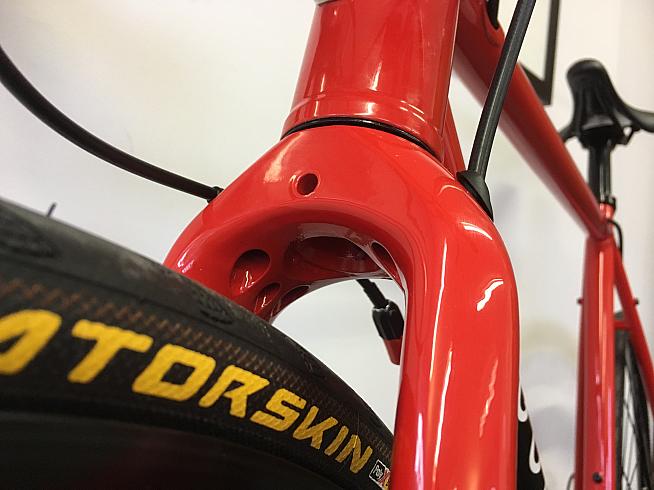
The forks are for quick release skewers, and I ask Jeff about the decision to spec this - he hasn't gone for through axles?
"No I haven't," he explains, "I tend to go down the line of, if I haven't tested it it doesn't go on the bike. I think that through axles might be the next thing that we look at, because it does add that bit more stability. So maybe that's one of the things that will come in a later version because i can see the benefit of that.
"Certain other things like press fit bottom bracket and things like that - it's horrible! I mean I know why they did it, i just think they shouldn't promote it for everything."
As for the post mount brake fittings, Jeff has considered the currently in vogue flat mount, but "no one can really give me an answer as to what the advantage is". Besides, it would mean routing external cables along the downtube rather than neatly tucked into the top tube and then down the seat stay.
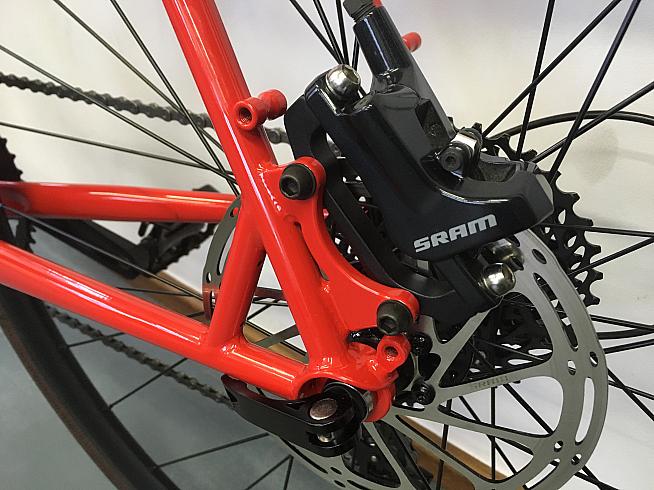
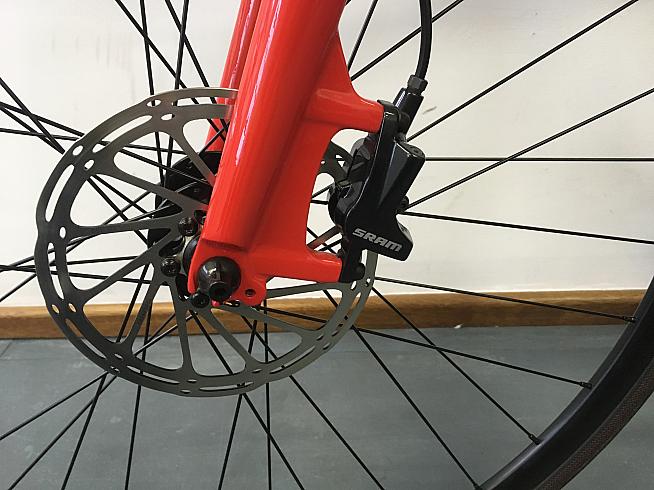
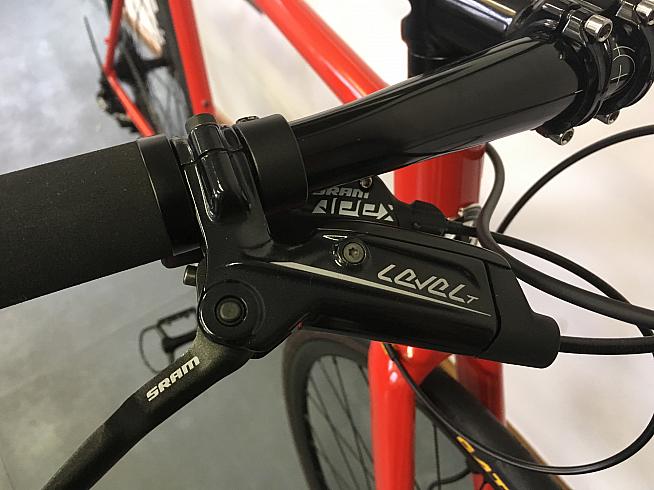
The internal cable routing on the top tube is one of my favourite features on the Rodax; it gives the bike the look of a premium, bespoke frameset. But it doesn't just look good, function has been considered as well as form: Jeff explains that there's actually a copper tube inserted inside the top tube as a cable guide. This means that if any water should enter the cable port, it will run straight out the other end without coming into contact with - and, over time, corroding - the steel frame from the inside.
The bike uses 160mm rotors front and back, and the whole frame is ISO-tested to make sure it's strong enough. In fact, Jeff shows me a raw prototype frame that has been returned after ISO testing - with a neat slice cut out of the bottom bracket to render it unusable after the extensive stress tests it's been subjected to. "Yes, they're conscientious" he grins.
The Rodax uses Goldhawk-branded finishing kit specced to Jeff's requirements - he is particularly pleased with the saddle, which he commissioned from another supplier based on a uniquely comfortable but no longer produced model he found on a test bike.
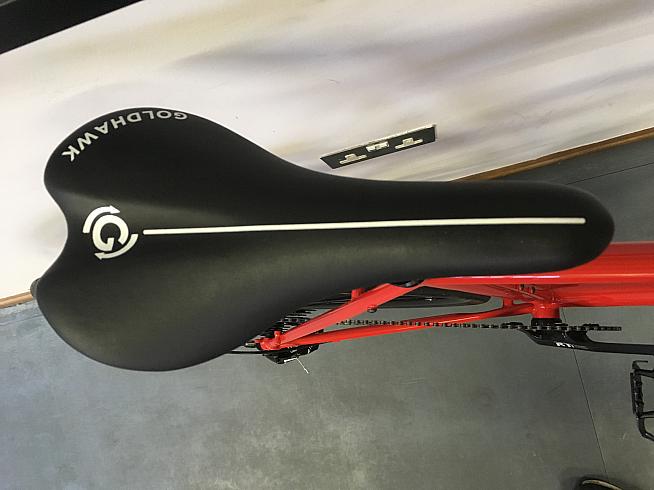
The wheels use KT hubs and shallow alloy rims by Jalco designed to take up to a 35mm tyre. I'm impressed with the tyre choice: Jeff has specced 28c Continental Gatorskins, a trusted favourite for many cyclists.
"I was running 25s on the demo bike," Jeff explains, "then I saw that everyone was going back to a slightly wider tyre so I put the 28s on thinking ok, it's going to be a bit more slow... but it was quite a game changer. It really brought everything nicely into line, and I wouldn't have guessed that from the outset, you know. I would have thought I was going to lose a bit of speed, but it really makes everything just right.
"It's a bit more comfortable, but also people are saying - and I don't quite understand the maths in it, I'll have to get my calculator out - but the thinking now is that the wider ones are slightly faster."
The more I look at the Rodax sitting in front of us as we speak, the more I'm tempted to fit some shallow drop bars, or even retro style porteur bars, and give the Goldhawk a tilt at some of that trendy gravel terrain that everyone's chasing. Has Jeff considered running 'cross tyres on the Rodax?
"I've run Conti cyclocross 35s on them, and that was great - they're just not very pretty!" he laughs.
"I do ride towpaths and things like that, but 80 per cent of my riding is roads. I think it's better to keep your bike suited to where you ride most, rather than try to spec it for every eventuality - meaning that most of the time, you're riding a bit of a compromise.
He sits back for a few seconds and considers.
"If you want the blurb on this, I ride for me: I'm not a member of a club, I don't do anything like that; I like to ride fast but I don't like a drop bar. A lot of the flat bar bikes out there - and I'm not saying there aren't any nice ones, because there are - but a lot of them left me a bit underwhelmed.
"I was constantly seeing someone put some individual nice bikes together and I was thinking 'That's great', then I'd go into a bike shop and look at the range and think, 'Oh... is that it?'
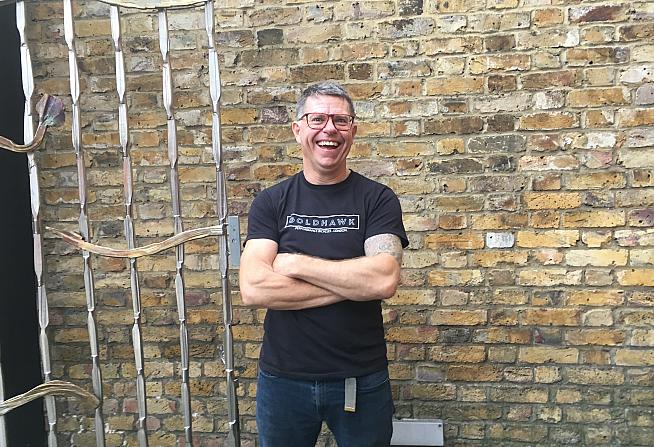
"And then I was looking for a career change - I've got a young family now, and I was spending six months of my life abroad. So I had a chance to get out of doing that, and at the same time this idea came along and it was something like, this really is an opportunity and if I don't take it now, it's not going to happen. So i took the plunge. I quit my job - yeah, it was terrifying.
"This bike as you see it now is probably two and a half years worth of development. There were four or five early versions where I was messing around with the frame geometry - and in those days, that was a case of taking some frames that I had and chopping them up, and re-welding them..."
You did your own welding?
"Yeah, but... even when I rode them, I was fingers crossed! My welding's not that great, it's just enough to get by. So that took a while, the first one I welded I got someone to re-weld for me. And then it was, 'So I've got this frame now' and ordering the first prototype frames - and that takes six months. So then you get them, you ride them for a bit and think that's great, and that takes six months.
"The timeline really goes out quickly, so it's four years ago that I quit the rat race. It's painful, because even the shipment takes six weeks from when they say it's on its way until you get it. And now you've spent the money, you know... now it's time to make it work!"
The early signs are that Jeff is indeed going to make it work: a store room in Goldhawk's borrowed office space is stacked to the rafters with boxes full of framesets, ready to be hand-assembled as the orders come in.
A frameset on a work stand is half built, and I note the Goldhawk head badge hasn't been fitted yet; Jeff explains that he fits these himself, using a 3D-printed template to ensure they're perfectly centred.
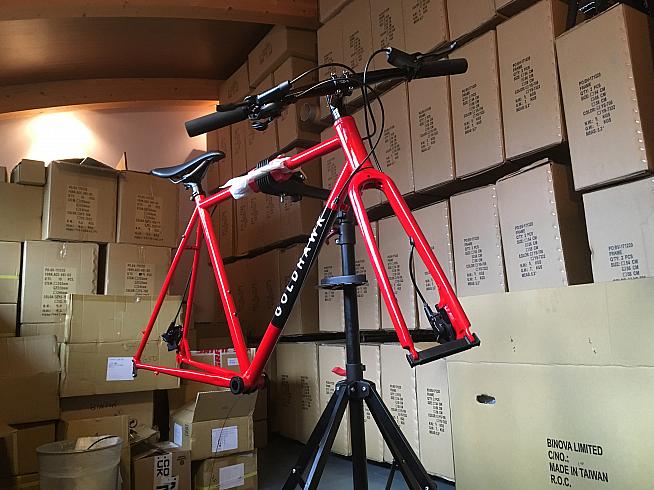

And, once the bikes leave the workshop, the early Rodax models are already being taken on some adventurous trips by their new owners. The week of my visit, he has loaned a Rodax to a friend's partner who is riding from London to Germany for the weekend.
The loanee is, Jeff says, Goldhawk's ideal rider: "She wakes up in the morning and says 'I'm going to ride to Brighton'. She came to me last week and said I'm going to a party in Cologne next week and I'm going to ride there. She's been riding her partner's Rodax quite a lot and has loved it for long distance. So when she said she was going to do that ride I said I'd lend her a bike.
"It's a flat bar bike but you can go and do some fast, long rides on it and she's come in and said 'Can I borrow one because I like it, and I'm popping over there.'"
I can't resist any longer: I ask Jeff can I take the Rodax for a quick spin down the street.
My spin down some Camden back streets isn't quite London-Cologne, but even on the short ride I'm impressed. The Rodax feels lively and urgent... in a word, fun. The brakes are quietly effective, and the derailleur shifts instantly up and down the cassette.
I stop in a local park to take some photos next to a rosebed, and admire the 'sprint red' paintwork glowing under the weak winter sun.
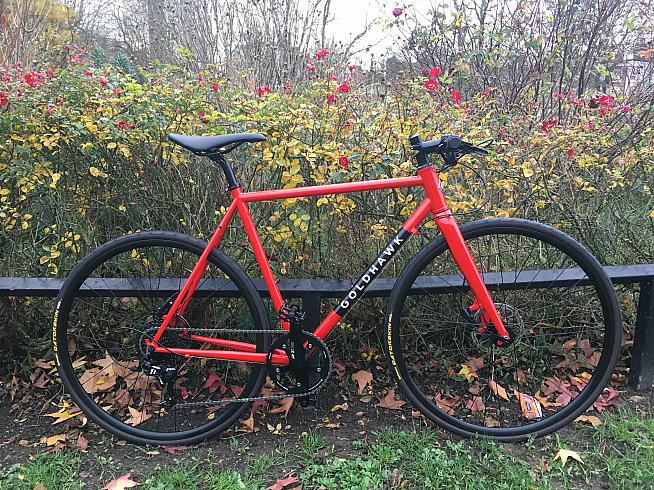
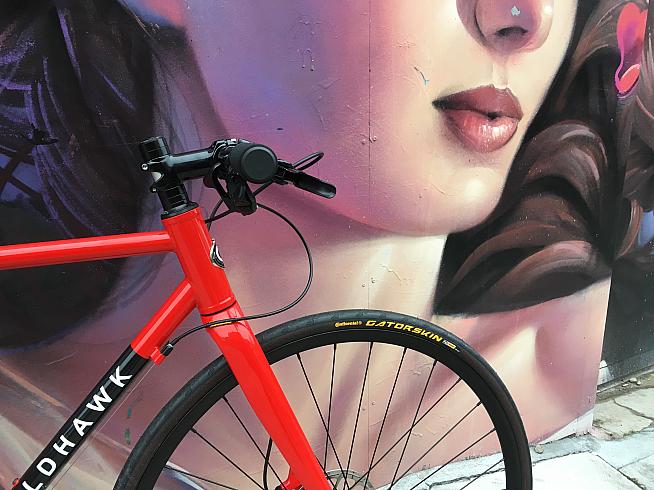
The Rodax really is an impressive bike, and for fast urban riding I'm convinced Jeff has put together a compelling package. I just wonder if it might be capable of even more than he envisages... it's already got mounts for mudguards and a pannier rack. Add perhaps a set of aerobars, some bike luggage, and you're all set for a spot of cycle touring - or even something like the Trans Alba Race?
Ultimately, that's for Goldhawk's customers to decide - and for those who choose the Rodax, I imagine they'll be very happy indeed.
Goldhawk Rodax, £1400 from goldhawkbikes.com.
0 Comments





